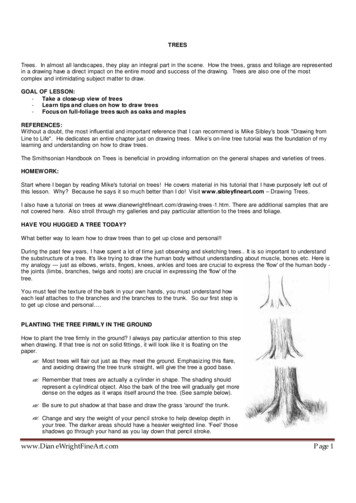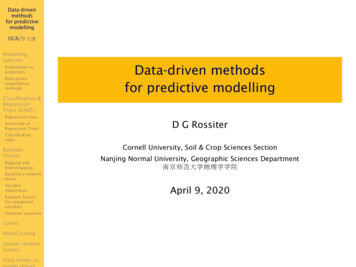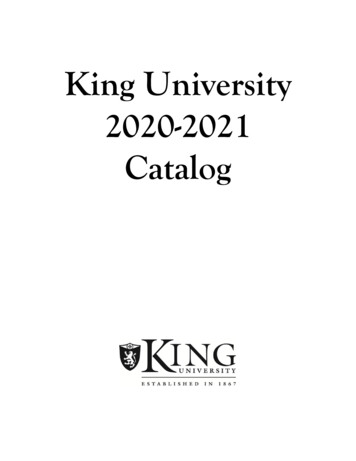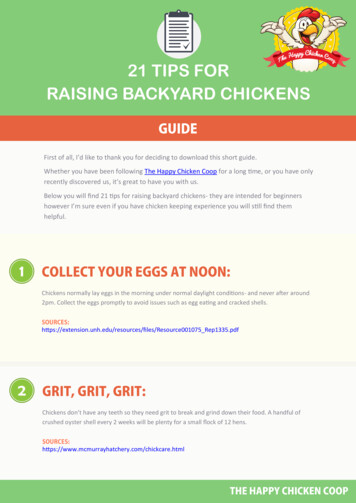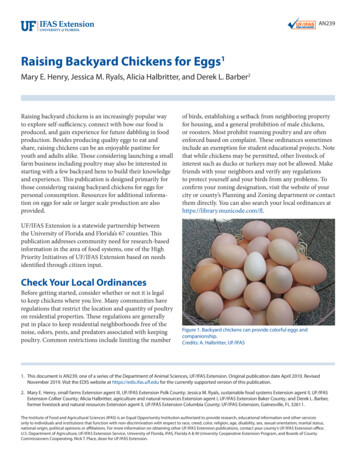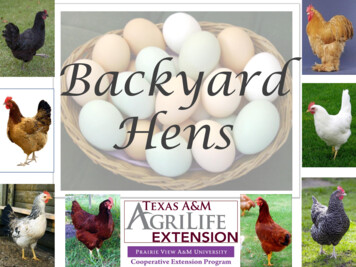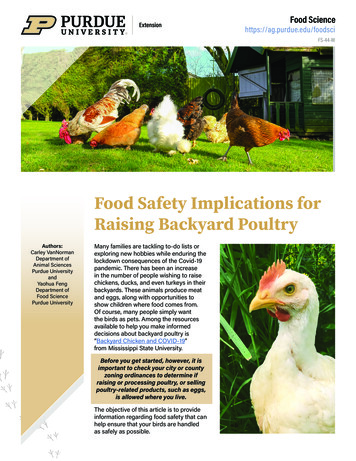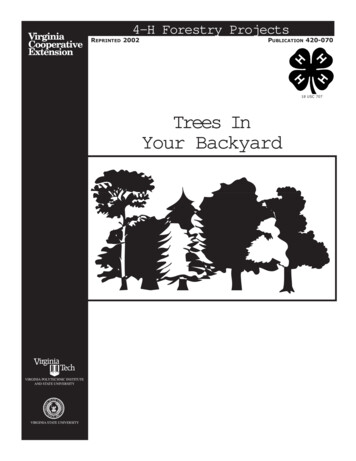
Transcription
4-H Forestry ProjectsREPRINTED 2002PUBLICATION 420-07018 USC 707Trees InYour BackyardVIRGINIA POLYTECHNIC INSTITUTEAND STATE UNIVERSITYVIRGINIA STATE UNIVERSITY
4-H Forestry ProjectsBook One: Trees In Your Backyardby Jeff Kirwan, Extension Specialist, Virginia Tech, College of Natural ResourcesWhat’s Inside:Activity 1. Looking at Leaves - Broad-leaved TreesActivity 2. Looking at Leaves - Needle-leaved TreesActivity 3. Using a Key to Identify TreesActivity 4. Making a Leaf CollectionActivity 5. Making a Seed CollectionActivity 6. Nominating a Big TreeActivity 7. Ideas for Exhibits, Presentations, CommunityServiceHelpful Web SitesFor tree e.htmFor Virginia 4-H Projects and te to Parents:This project introduces youth to the study of trees by having them look atthe leaf characteristics of trees in their backyard or nearby forest. The illustrations in this book represent 22 of the most common trees in Virginia. Youthmay want to purchase or borrow a tree identification guide to help with someof the less common species.
Activity 1Looking At Leaves - Broad-Leaved Trees Step 1. Look at the arrangement of buds and leaves on a stem. Learn to recognize thedifference between opposite and alternate arrangement. There are only three major trees in Virginia that have opposite arrangement. Think ofthe word “MAD” for Maple, Ash, and Dogwood.Step 2. Learn to recognize the difference between simple and compound leaves. Simpleleaves have a single blade emerging from one bud. Compound leaves have three ormore leaflets emerging from one bud. LeafletCompound HickoryDouble-Compound HoneySimpleSimpleTrees In Your Backyard1
Step 3. You will also need to recognize leaf lobes and their shapes.Rounded lobesRounded lobesPointed lobesPointed lobesNO lobesStep 4. Look at the edges, or margins of a leaf. Many leaves are toothed, or serrated.Others are not.Blackgum orActivity 2Looking At Leaves - ConifersMost conifers have needle-like leaves and are evergreen. The fruit of conifers is a cone,which is actually a “stage” for releasing seeds. To identify conifers, look at the form andnumber of needles.Needles Scale-like2Trees In Your BackyardSingle Needles2 Needle ClusterVirginia Pine3 Needle ClusterLoblolly PineNeedle Clusters
Activity 3Use This Key To Identify Several TreesKey To Leaves Of Virginia TreesI. Leaves Broad; definitely not needle-like or scale-like; mostly deciduousA. Leaves, buds, branches have opposite arrangement - maple, ash, dogwoodB. Leaves, buds, branches have alternate arrangement1. leaves are compound - walnut, hickories, locust2. leaves are simplea. leaves have rounded lobes - white oaks, sassafras, mulberryb. leaves have pointed lobes - red oaks, sycamore, sweet gum, hollyc. leaves have no lobesi. leaves have smooth (entire) margins - willow oak, live oak, paw-paw,redbud, tupelo, persimmon, magnoliaii. leaves have toothed margins - willow, birch, true poplars, birch,hornbeam, chestnut, elm, hackberry, cherry, sourwood, basswoodII.Leaves needle-like (pines) or scale-like (cedar)A. needles in clusters or bundles (pines)1. 5 needle clusters - white pine2. 3 needle clusters - loblolly pine3. 2-3 needle clusters - short-leaf pine4. 2 needle clusters - Virginia pineB. needles appear singly, not in clusters1. needles 4-sided, roll between fingers - spruce2. needles 2-sided, do not roll - eastern hemlock3. needles feather-like, found growing in swamps - baldcypressC. needles are scale-like, overlapping to make branches that look flat.1. fruit a berry-like cone - redcedarTrees In Your Backyard3
2. fruit like a small pine cone - white cedarActivity 4Making A Leaf CollectionMaking a leaf collectionA leaf collection is easy to make and does not injure a tree as long as you are careful toremove only one or two leaves. To make a collection for display, you will need to dryyour leaf for several days in a flat position, then glue your leaf to heavy paper. Seriousddel o rFi e cRFiR e eldcord4Trees In Your Backyard
students and professionals use a leaf press to dry their leaves, but you can use a tele-Field recordField recordCommon name:Common name:Date:Date:Location:Location:Where collected: woods yard near stream or river hillside otherWhere collected: woods yard near stream or river hillside otherNotes:Notes:Field recordField recordCommon name:Common name:Date:Date:Location:Location:Where collected: woods yard near stream or river hillside otherWhere collected: woods yard near stream or river hillside otherNotes:Notes:Trees In Your Backyard5
phone book. Be sure to complete a fieldrecord for each tree you identify.Copy this page so that you will have enoughField Records to complete your project.Activity 5Making A Seed CollectionMost seeds ripen in the fall, but some can becollected in spring and summer. Try to get asPomeWild Crab AppleSamaraAshes, ElmsMaplesGroup of SamarasYellow PoplarNut (Dehiscent Husk)Hickory6Trees In Your BackyardDrupeCherryMultiple Fruit ofSmall drupesRed MulberrySamaraSlippery ElmStrobile:Winged NutletGray BirchNut(Indehiscent)Oak AcornBerryPersimmonDouble SamaraSugar MapleGroup of FolliclesMagnoliaMultiple (Head of Nutlets)SycamoreLegumeBlack & Honey LocustCapsulesMountain Laurel & WillowNutletHornbeamConeHemlock
Activity 6Nominating a Big Tree4-H Member Big Tree Report Form18 USC 707You can report a big tree online or by filling out the form below and mailing to:Extension Specialist, 4-HCollege of Natural Resources (0324)Virginia TechBlacksburg, VA 24061Name:E-mail:Address:County where tree is found:Species (scientific name):Species (common name):Circumference at 4.5 ft to nearest half inch:Date measured:Property owner’s name:Location of the tree:(provide directions from the nearest state road intersection):Visit the 4-H big tree website: http://www.fw.vt.edu/4h/bigtree/youth.htmlTrees In Your Backyard7
many types of seeds as you can. Use an “organizer” box to keep your seeds separated.Label each type of seed with the common name of the tree that produced it.Activity 7Ideas For Exhibits, PresentationsAnd Community ServiceExhibits Collection of nuts, fruits and seeds of trees Leaf collection (dried, and pasted on paper) Wood samples (blocks of wood, labeled) Photographs (compare bark or shape of trees) Drawings (compare trees growing in different environments, or at different ages)Presentations “The 10 most important trees of County” “How to identify trees” (show examples of opposite vs. alternative, simple vs.compound) “How trees are used” (show examples of paper, lumber, veneer, plywood, etc.) “The pines of Virginia” (do a combination of identification and uses) “The white oak tree” (tell all you know about one species)Citizenship Keep a scrapbook that illustrates the value of trees to people, and show it to others. Read a book about trees to a younger audience. Donate a leaf/seed/photo collection to a library or teacher. Identify the trees at your school for nature study. Help organize or conduct an Arbor Day activity. Draw a poster about trees or forests, and exhibit it in a public place. Take your club members for a hike and show them how to identify trees. Assist with teaching a nature class at camp. Make a video about trees, and show it to a group. Lead a tree walk at vacation bible school or church school.8Trees In Your Backyard
Nominate a big tree.Activity 84-H Tree Identification Project RecordYour NameAddressName of your School or 4-H ClubPart A. Note the name, location, and date of any trees you learn to identifyName of treeLocation of treeDateNotesEx. White oakmy back yard at home9/15/01acorns on ground1.2.3.4.5.6.7.8.9.10.Part B. Complete at least one of the following activities.Activity1. Exhibit your collection of leaves, fruits, or other items2. Give a presentation on tree identification or forestry.3. Do a citizenship activity related to forestry.Date CompletedPart C. My 4-H StoryOn a separate sheet of paper, write about your experiences in this project. Tell us thingslike how you selected your trees for study, and what books or resources you used toidentify them. Also tell us what trees were hard to identify, and how you solved anyproblems. Finally, tell us how you communicated with others when you were learningabout trees and having your work checked by an adult. Did you say, “thank you” tothose who helped you?Trees In Your Backyard9
Virginia Cooperative Extension programs and employment are open to all, regardless of race, color, religion, sex, age, veteranstatus, national origin, disability, or political affiliation. An equal opportunity/affirmative action employer. Issued in furtherance of Cooperative Extension work, Virginia Polytechnic Institute and State University, Virginia State University, and the U.S.Department of Agriculture cooperating. J. David Barrett, Director, Virginia Cooperative Extension, Virginia Tech, Blacksburg;Lorenza W. Lyons, Administrator, 1890 Extension Program, Virginia State, Petersburg.VT/643/0302/1M//420070
A. Leaves, buds, branches have opposite arrangement - maple, ash, dogwood B. Leaves, buds, branches have alternate arrangement 1. leaves are compound - walnut, hickories, locust 2. leaves are simple a. leaves have rounded lobes - white oaks, sassafras, mulberry b. leaves have pointed lobes - red oaks, sycamore, sweet gum, holly c. leaves have .

